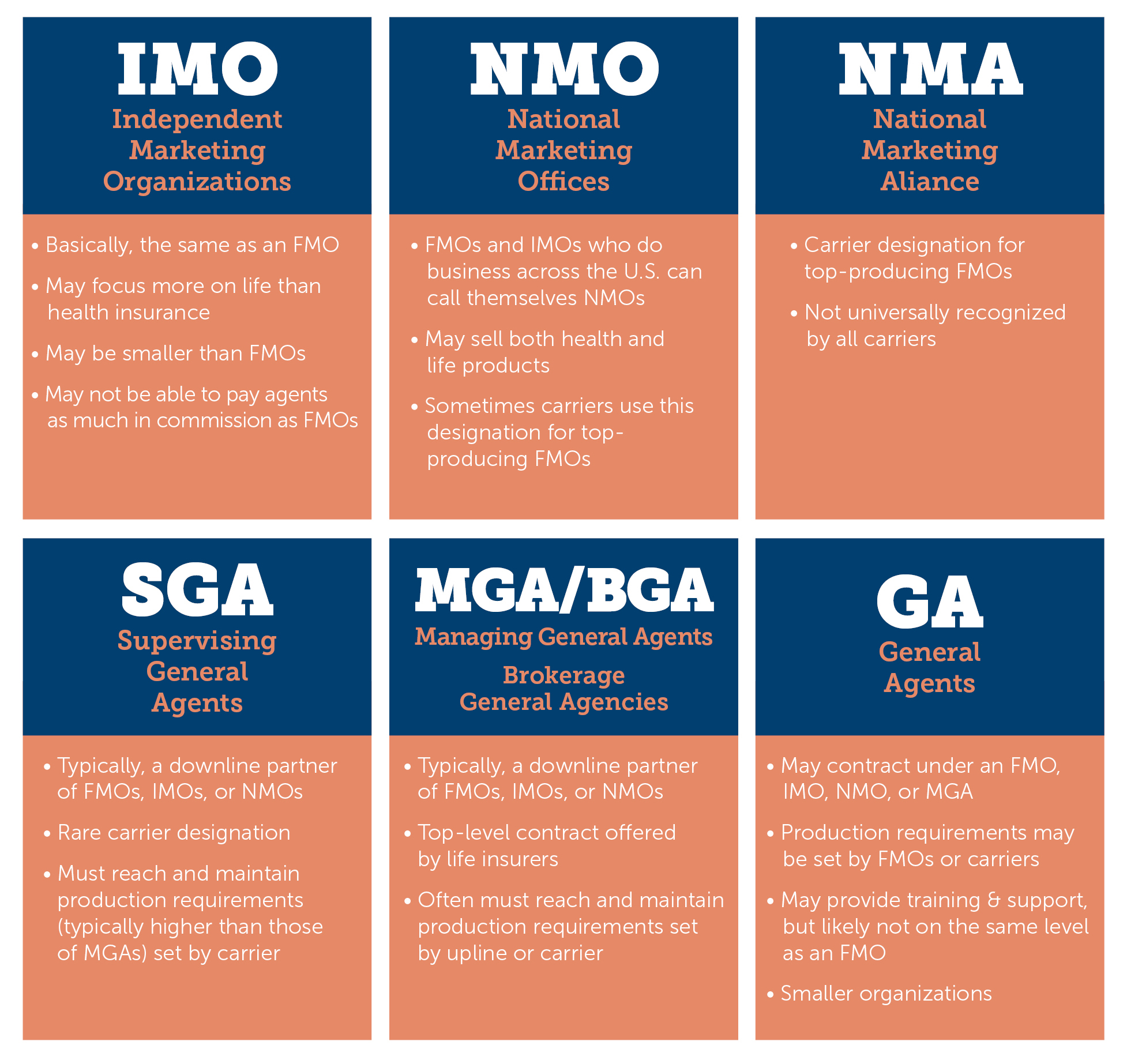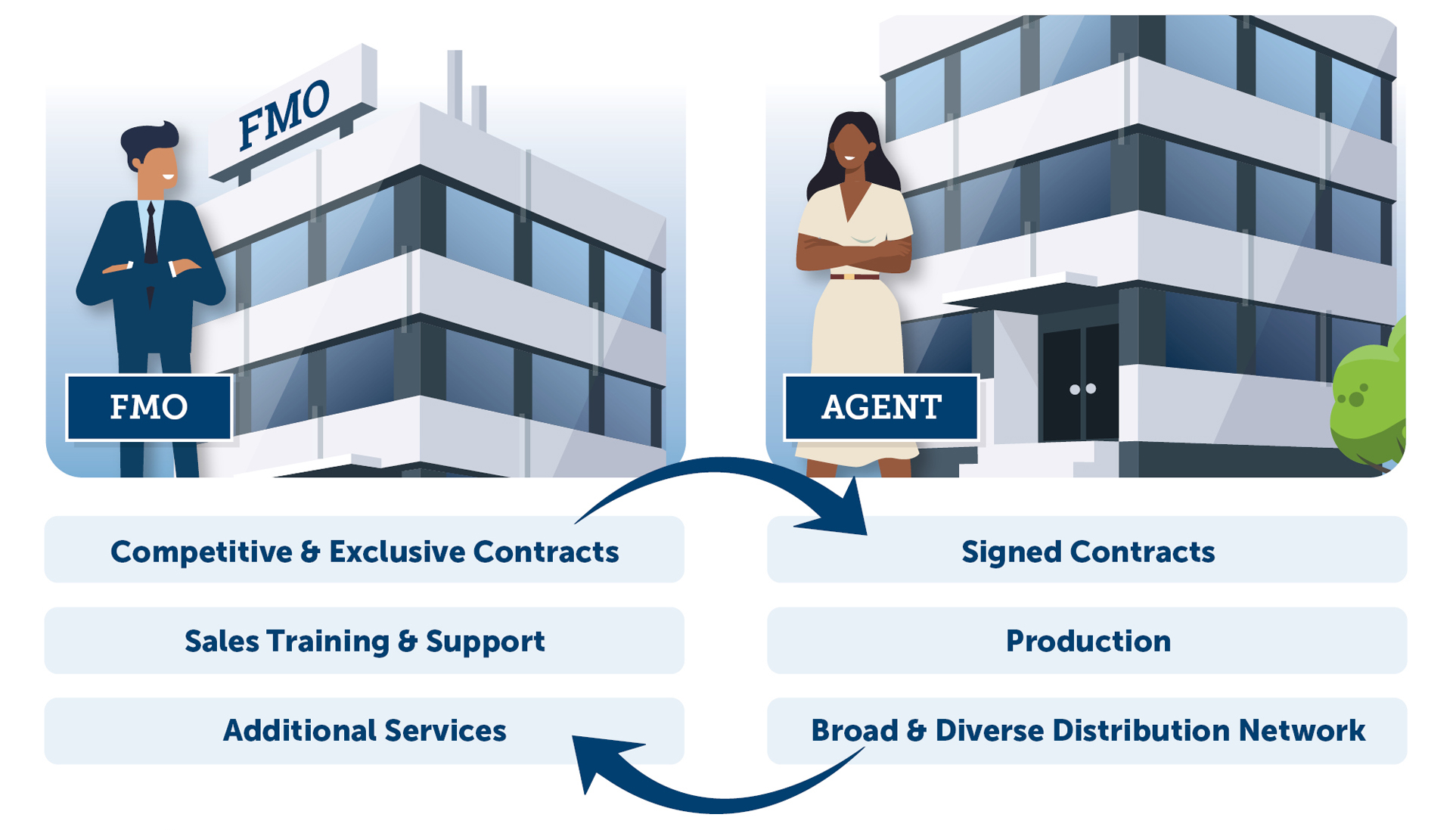For decades, field marketing organizations (FMOs) have played an integral role in the marketing, selling, and distributing of insurance products. Acting as a bridge between agents or agencies and insurance companies, they bring together the two sides in a mutually beneficial, contractual relationship.
But how do the contracts work? What about your commissions? What are the perks? We explore all the ins and outs of FMOs — what they are, how they’re structured, how agents get paid, all the services they can offer, and more in this guide.

What Is an FMO?
At the most fundamental level, an FMO is a company acting as a liaison between an insurance carrier and agent. The FMO connects the two parties through a contract, which permits the independent agent to sell the carrier’s products. When they sell a policy, the agent earns a sales commission from the carrier. Usually, FMOs work with hundreds to thousands of agents, represent multiple big- and small-name carriers, and offer many different kinds of services besides helping agents get a contract.
FMO Basics
Broadly, FMOs that work in the health and life insurance industry may specialize in a particular market, such as Medicare, marketplace, or life insurance. Even if they focus on certain markets, they may also offer contracting for other products, like ancillary insurance (e.g., long- and short-term care, final expense, dental, vision, hearing, critical illness, cancer, or travel insurance) or annuities. Agents can form relationships with as many FMOs as they desire, although not all FMOs will be able to offer the same level of contracts, service, technology, and tools depending on their size and resources.
It’s important to note, there aren’t set standards for what qualifies an organization as an FMO, which means that anyone assisting a group of agents with contracting can technically give themselves the name. An FMO could have relationships with more than 10,000 agents or be an agency and have relationships with just 10. Larger FMOs assisting more than 1,000 agents and offering contracts from more than 100 carriers will generally be better equipped with more resources, portfolio options, and tools. These numbers are a little arbitrary and just a jumping off point. We’ll teach you how to discern whether an FMO meets your needs beyond the numbers.
Because there is no standardization for FMOs, carriers end up deciding who qualifies. Each carrier decides a little differently, creating different labels and standards for FMOs depending on production requirements. Carriers will also define product requirements differently or even introduce new names for certain top-producing FMOs.
What are some other names you may hear an FMO called?
Similar Types of Marketing Organizations & Agent Designations
There are many classifications for marketing organizations of insurance agents beyond FMO — including IMO, NMO, NMA, MGA, and GA. What do these mean, and are they really different than an FMO?
Here are these other acronyms explained:

For clarity, in the rest of this guide, we’ll group FMO, IMO, NMA, and NMO together under the general term “FMO” and group SGA, MGA, and GA under the general term “agency.”
Where FMOs Do Business
Depending on their insurance licenses, certifications, and which contracts they have with which carriers, FMOs can do business in one to all U.S. states. Larger FMOs will have more staff and resources to be licensed and able to do business in all states, representing a diverse assortment of carriers, contracts, and product types. However, not all carriers operate nationally nor have need to generate contracts on a large scale. A strong FMO will be able to do business in most to all states and offer their agents contracts from national, regional, and local carriers.
FMO Structure & Organization
Let’s dive into FMO structure and organization, looking at how FMOs work, the nature of the agent-FMO relationship, how contracting works through an FMO, and what hierarchies are and why they matter.
The Nature of the Agent-FMO Relationship
By now you know that FMOs are the intermediary between carriers and agents. But how does that work exactly?
It begins with an FMO forming a business relationship with an insurance company when the principal agent of the FMO (think CEO of the company) contracts with the carrier. Once the principal agent/FMO is contracted with a carrier, the FMO can then offer that contract to its agents.
Contracting forms the basis, and often beginning, of the relationship between an agent and FMO. The more contracts an agent has through an FMO, the greater the chance that the agent and FMO will profit. FMOs streamline and centralize the contracting process for agents. Instead of going to 10 carrier websites, finding contracts for each one, and working with 10 different people in different ways to submit and track everything, agents can go to one FMO and get 10 contracts. You can think of an FMO like a contract wholesaler. They stock your store for you with lots of different brands so that you don’t have to go to each brand and purchase inventory yourself, thus saving you precious time and effort.
Contracts offered by FMOs come in two different forms. Agents can either contract directly with the carrier through the FMO or contract with an FMO to sell plans from a carrier. The agreement between the FMO and carrier determines which kind of contract the FMO can then offer agents. Some carriers won’t contract directly with agents and only go through FMOs, which means that, if an agent wants to sell that carrier’s plan, they must form a relationship with an FMO. Differences between the two types of contracts include how agents get paid and what happens if the agent leaves the FMO. We’ll get into those specifics in the next chapter.
Ideally, the relationship doesn’t begin and end with contracts and is even further a mutually beneficial and symbiotic arrangement.

The FMO provides agents with contracts and a wide array of services, and in turn, the agents sign the contracts, giving the FMO product sales, which make everyone money, and a wider network, which improves the FMO’s standing in the carrier’s eyes. It’s a win-win.
Learn More Inside How Insurance FMOs Work!
Have you ever found yourself asking, “Wait, what’s an FMO exactly?” Then this eBook is for you! In 45 pages, we answer your lingering questions about how these organizations function. Explore FMO basics, structure and organization, how agents and FMOs get paid, what FMOs can do for you, and what to look for when choosing a partner. Learn why joining an FMO is often a smart choice for your insurance business.
BONUS: Enjoy three fun extras at the end, including questions to ask an FMO before joining, A Day in the Life of an FMO, and what you get when you register with Ritter!
Take a Look!
We sincerely hope this guide helps you easily understand the ins and outs of how FMOs work and accomplish your business goals! Fill out the form to get your free download today.
Results may vary based on individual user and are not guaranteed.
